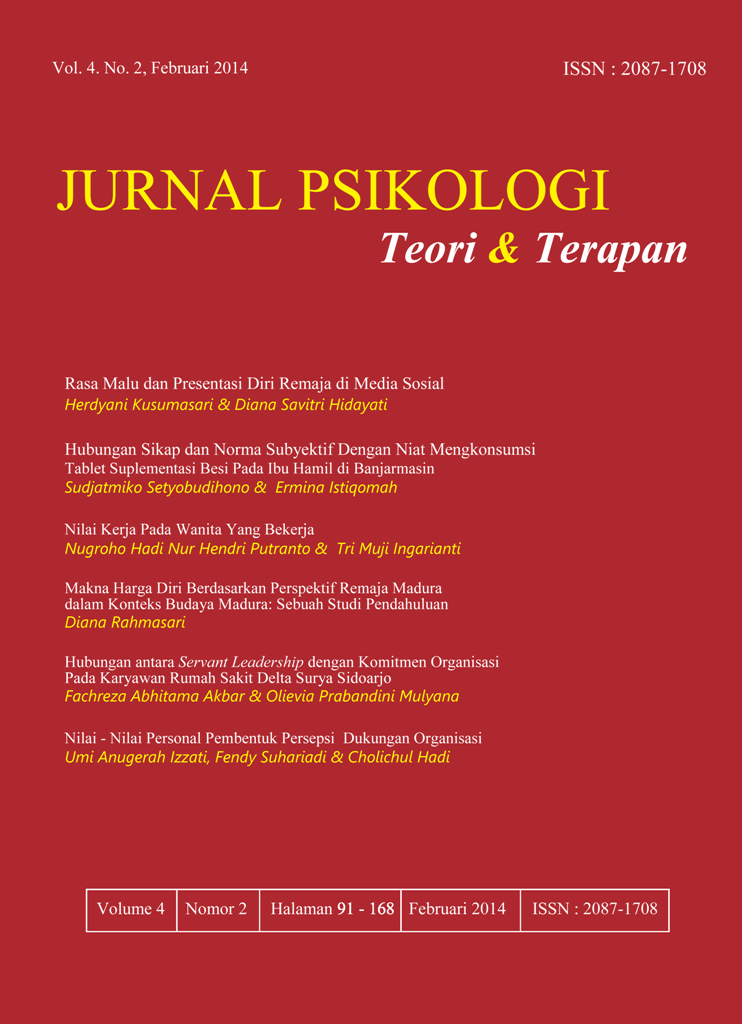RASA MALU DAN PRESENTASI DIRI REMAJA DI MEDIA SOSIAL
DOI:
https://doi.org/10.26740/jptt.v4n2.p91-105Keywords:
Rasa Malu, Presentasi Diri, Media Sosial, RemajaAbstract
An individual will perform self-impression to be accepted by society and can establish a social relationship. Someone do the self presentation so they can be accepted by the environment. However, there are some people which have obstacle to do their self presentation to make a social relationship. We can called that condition with shyness. Social media can be well accepted a mediator for shy person to presented their self. The purpose of this research is to find out the correlation between shynees with self presentation on adolosence in social media. This research has done to 96 sample of 13 16 years old active user of social media like Facebook, Twitter, Path, Instagram, Blog, and Youtube. The result with Pearson Product Moment test says the coeficient correlation (r) between two variables is 0,281. That is shows that between the two variables have a positive correlation with the signification level is 0,006 (p < 0,05) which says that the two variables have a significant correlation.
Abstrak: Individu akan melakukan pengelolaan kesan agar dapat diterima oleh masyarakat dan dapat menjalin sebuah hubungan sosial. Presentasi diri dilakukan agar individu dapat diterima dengan baik oleh lingkungan sekitarnya. Namun, beberapa orang akan mengalami suatu hambatan dalam melakukan presentasi dirinya secara langsung untuk melakukan suatu hubungan sosial. Kondisi tersebut dapat dikatakan sebagai rasa malu (shyness). Media sosial merupakan salah satu perantara bagi orang pemalu untuk melakukan presentasi dirinya. Tujuan dari penelitian ini adalah untuk mengetahui hubungan antara rasa malu dengan presentasi diri remaja melalui media sosial. Penelitian ini dilakukan pada 96 orang remaja berusia 13 16 tahun yang aktif di media sosial yaitu Facebook, Twitter, Path, Instagram, Blog, dan Youtube. Hasil yang diperoleh dengan uji Pearson Product Moment menunjukkan koefisien korelasi (r) antara kedua variabel sebesar 0,281 dengan taraf signifikasinya adalah 0,006 (p < 0,05), hal tersebut menunjukkan bahwa antara kedua variabel memiliki hubungan positif yang signifikan.
References
Aliana, S. S. (2015). Wanita ini babak belur dipukuli teman kencan online. Diakses tanggal 07 Februari 2015 diperoleh dari http://teknologi.news.viva.co.id/news/read/586439-wanita-ini-babak-belur-dipukuli-teman-kencan-online
Arianna, P. F. (2014). Online self-presentation: examining the relationship between facebook use, narcissism, social anxiety, loneliness and self-esteem. A thesis submitted to the Department of Psychology at Glasgow Caledonian University in the candidacy for the master degree of science
Arroyo, A., Nevarez, N., Segrin, C., & Harwood, J. (2012). The association between parent and adult child shyness, social skills, and perceived family communication. Journal of Family Communication, 12, 249 - 264
Azwar, S. (2014). Reliabilitas dan validitas: edisi IV. Yogyakarta: Pustaka Pelajar
Azwar, S. (2001). Metode penelitian. Yogyakarta: Pustaka Pelajar
Baker, L. R., & Oswald, D. L. (2010). Shyness and online social networking services. Journal of Social and Personal Relationship, 27 (7), 1 22
Broto, G. S. D. (2014). Siaran pers tentang riset kominfo dan UNICEF mengenai perilaku anak dan remaja dalam menggunakan internet. Diakses tanggal 1 Juni 2014 diperoleh dari http://kominfo.go.id/index.php/content/detail/3834/Siaran+Pers+No.+17-PIH-KOMINFO-2-2014+tentang+Riset+Kominfo+dan+UNICEF+Mengenai+Perilaku+Anak+dan+Remaja+Dalam+Menggunakan+Internet+/0/siaran_pers#.U43KYnYQdKh
Carducci, B. J., & Golant, S. (2009). Shyness: understanding, hope, and healing. New York: Harper Collins
Civitci, N. (2010). Social comparison and shyness in adolescents. Egitim Arastirmalari-Eurasian Journal of Educational Research, 38, 90-107
Considine, M. E. (2012). Shyness: causes and impact. (Online). Diakses tanggal 25 Januari 2015 diperoleh dari http://www.netce.com/coursecontent.php?courseid=799
Crozier, W. R. (2001). Understanding shyness; psychological perpectives. Portland: Ringgold Inc
Dayakisni, T., & Hudaniah. (2009). Psikologi sosial. Malang: UMM Press
DeLamater, J. D., & Myers, D. J. (2007). Social psychology: sixth edition. Belmonth: Thomson Wadsworth.
DeGraaf, M. M. A. (2011). The relationship between adolescents personality characteristics and online self presentation. (Online). Diakses tanggal 15 Februari 2015 diperoleh dari http://essay.utwente.nl/60892/1/Graaf_de,_Maartje_-s_0188808_scriptie.pdf
Dingman, R. L., & Bloom, J. W. (2012). Managing shyness. Indiananpolis: Dog Ear
Ellison, N B., Steinfield C., & Lampe, C. (2007). The Benefits of Facebook œFriends: Social Capital and College Students Use of Online Social Network Sites. Journal of Computer-Mediated Communication, 12, 1143 1168
Fahmi, A. B. (2011). Mencerna situs jejaring sosial. Jakarta: Elex Media Komputindo.
Gibbs, J. L., Ellison, N. B., & Heino, R. D. (2006). Self Presentation in Online Personals. Communication Research, 33 (2), 152 177
Grietens, H. (1999). Attitudes towards social limits, undersocialized behavior and self-presentation in young people. Belgia: Leuven University Press
Hurlock, E. B. (1997). Psikologi perkembangan: suatu pendekatan sepanjang rentang kehidupan. Jakarta: Erlangga.
Hurlock, E. B. (1980). Psikologi perkembangan: suatu pendekatan sepanjang rentang kehidupan edisi kelima. (Terj. Istiwidayanti & Soedjarwo). Jakarta: Erlangga.
Jansen, A., Konig, C. J., & Melchers, K. G. (2010). The interactive effect of impression motivation and cognitive schema on self-presentation in a personal inventory. Journal of Applied Social Psychology
Latipun. (2011). Psikologi eksperimen: edisi kedua. Malang: UMM Press
Lenhart, A., Madden, M., Smith, A., & Macgill, A. (2007). Teens and Social Media. Diakses tanggal 04 Februari 2015 diperoleh dari http://www.pewinternet.org/2007/12/19/teens-and-social-media/
Lewis, M. A., & Neighbors, C. (2005). Self determination and the use of self presentation strategies. Journal of Social Psychology, 145 (4), 469 489
Maltby, J., Day, L., & Macaskill, A. (2007). Personality, individual defferences, and intelligence. Harlow: Pearson.
McLeod, S. (2008). Self concept. Diakses tanggal 25 Januari 2015 diperoleh dari http://www.simplypsychology.org/self-concept.html
Nurudin. (2012). Tuhan baru masyarakat cyber di era digital. Malang: Aditya Media Publishing
Ningrum, D. W. (2014). Demi selfie cantik, triana operasi plastik ratusan juta rupiah. Diakses tanggal 07 Februari 2015 diperoleh dari http://tekno.liputan6.com/read/2042789/demi-selfie-cantik-triana-operasi-plastik-ratusan-juta-rupiah
OKeeffe, G. S., & Pearson, K. C. (2011). Clinical report: the impact of social media on children, adolescents, and families. Journal of the American Academy of Pediatrics, 127 (4), 800 804
Papalia, D. E., Olds, S. W., & Feldman, R. D. (2009). Human development: perkembangan manusia, edisi 10. Jakarta: Salemba Humanika.
Rovai, A. P., Baker, J. D., & Ponton, M. K. (2013). Social science research design and statistics: second edition. Virginia: Watertree Press
Rui, J., & Stefano, M. A. (2012). Strategic self-presentation online: a cross-cultural study. Computers in Human Behavior, 29, 110 118
Santrock, J. W. (2003). Adolescence perkembangan remaja. Jakarta:
Erlangga.
Sarwono, S. W., & Meinarno, E. A. (2012). Psikologi sosial. Jakarta: Salemba Humanika
Stein, M. B. (2002). Triumph over shyness: conquering shyness and social anxiety. New York: McGraw-Hill
Schlenker, B. R., & Leary, M. R. (1982). Social anxiety and self presentation: a conseptualization and model. Psychological Bulletin, 92 (3), 641-669.
Uyanto, S. S. (2009). Pedoman analisis data dengan SPSS: edisi 3. Yogyakarta: Graha Ilmu
Wong, W. K. W. (2012). Faces on facebook: a study of self presentation and social support on facebook. SS Student E-Journal, 1, 184 214
Zarghooni, S. (2007). A study of self-presentation in light of facebook. Paper was published on Institute of Psychology, University of Oslo
Zuriah, N. (2009). Metodologi penelitian sosial dan pendidikan: teori-aplikasi. Jakarta: Bumi Aksara
Downloads
Published
How to Cite
Issue
Section
License
Authors who publish in this journal agree to the following terms:
Copyright in any article is held by the author.
The author grants the journal, publication rights with the work simultaneously licensed under a Creative Commons Attribution License that allows others to share the work with an acknowledgment of the work's authorship and initial publication in this journal.
Authors may enter into separate, additional contractual arrangements for the non-exclusive distribution of the journal's published version of the work (e.g., posting it to an institutional repository or publishing it in a book), with an acknowledgment of its initial publication in this journal.
Authors are permitted and encouraged to post their work online (e.g., in an institutional repository or on their website) prior to and during the submission process, as this can lead to productive exchanges, as well as earlier and greater citation of published work.
 Abstract views: 11409
,
Abstract views: 11409
, PDF Downloads: 8695
PDF Downloads: 8695


















